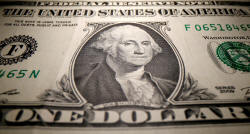Dollar at one-week high as jobs test looms
 Send a link to a friend
Send a link to a friend
 [August 06, 2021] By
Sujata Rao [August 06, 2021] By
Sujata Rao
LONDON (Reuters) -The dollar crept higher
on Friday, lifted by a rise in U.S. inflation-adjusted bond yields to
one-week highs and expectations of a strong set of employment data that
could make the case for faster U.S. policy tightening.
Federal Reserve Vice Chair Richard Clarida laid the groundwork for
dollar gains by suggesting this week that conditions for hiking interest
rates might be met as soon as late 2022.
Clarida's remarks lifted Treasury yields after five weeks of declines
while "real" yields, excluding inflation, are set to snap a six-week
streak of declines.
U.S. non-farm payrolls data is due at 1230 GMT. Forecasts for jobs
created last month vary widely from 350,000 to 1.6 million, and the
consensus figure is 870,000.
A number that size or larger could lift the dollar further, especially
against the euro and the yen, which will not see any policy tightening
for years more.

Steve Englander, global head of FX research at Standard Chartered, said
that even a figure close to the current consensus could provoke a market
reaction.
"A major piece of data that can be read as an optimistic signal could
firm up rate expectations," he said, particularly as markets have
recently backed away from pricing in hikes.
By 1115 GMT, the dollar traded at a one-week high at 92.43 against a
basket of currencies, having eked out a 0.4% gain so far this week
following last week's 0.9% fall which was its worst since May.
Against the euro, it stood at $1.1805 or up 0.2%. The euro was also
pressured by weaker-than-expected German industrial orders data.
Against the yen, the greenback touched a one-week high of 109.82
Japanese yen.
Expectations grew on Thursday for a strong set of U.S. jobs numbers
after initial claims for state unemployment benefits fell by 14,000 to
385,000 in the week ended July 31, and layoffs dropped to their lowest
in more than 21 years.
[to top of second column] |

A U.S. dollar banknote is seen in this illustration REUTERS/Dado
Ruvic/Illustration/File Photo

Longer-term, the impact of Clarida's hawkish comments is unlikely to last, said
Vasilieos Gkionakis, global head of FX strategy at Lombard Odier Group.
"On the whole, I still think we're in the phase in the business cycle where
growth and global trade are going to remain relatively solid, and that's going
to provide some downside bias for the dollar," he said.
That view was echoed by a Reuters poll of strategists, with most predicting a
dollar fall over the next year.
Elsewhere, the New Zealand dollar is on course for its best week since late June
following a sharp drop in unemployment that all but cemented expectations of an
interest rate hike this month.
The kiwi last bought $0.7052 and the Australian dollar bought $0.7390, slightly
lower on the day [AUD/]
A path to rate hikes was also mapped out by the Bank of England on Thursday,
supporting sterling, which fetched $1.391.
But the firm dollar, alongside rising COVID-19 infections, is hitting emerging
currencies, with the Thai baht at a three-year low, down more than 7% in seven
weeks. The Turkish lira meanwhile slipped 0.7% to a two-week low.
(Reporting by Sujata Rao and Ritvik Carvalho in London and Tom Westbrook in
Singapore; Editing by Timothy Heritage and Emelia Sithole-Matarise)

[© 2021 Thomson Reuters. All rights
reserved.] Copyright 2021 Reuters. All rights reserved. This material may not be published,
broadcast, rewritten or redistributed.
Thompson Reuters is solely responsible for this content. |